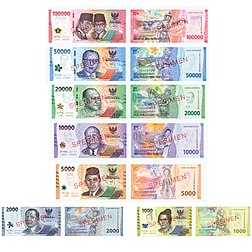
Back روبية إندونيسية Arabic روبيه اندونيسيه ARZ Rupia indonesia AST İndoneziya rupiyası Azerbaijani Rupiah BBC Rupiah kan Indonesya BCL Інданезійская рупія Byelorussian Інданэзійская рупія BE-X-OLD Tun Indonésia BEW Индонезийска рупия Bulgarian
 The latest currency issued by Bank Indonesia as of August 2022 | |
| ISO 4217 | |
|---|---|
| Code | IDR (numeric: 360) |
| Subunit | 0.01 |
| Unit | |
| Plural | The language(s) of this currency do(es) not have a morphological plural distinction. |
| Symbol | Rp |
| Denominations | |
| Superunit | |
| 103 | ribu (thousand) |
| 106 | juta (million) |
| 109 | miliar (billion) |
| 1012 | triliun (trillion) |
| Subunit | |
| 1⁄100 | sen (cents, obsolete)[a] |
| Banknotes | |
| Freq. used | Rp1,000, Rp2,000, Rp5,000, Rp10,000, Rp20,000, Rp50,000, Rp100,000 |
| Rarely used | Rp75,000 (commemorative) |
| Coins | |
| Freq. used | Rp500, Rp1000 |
| Rarely used | Rp50, Rp100, Rp200[1] |
| Demographics | |
| Official user(s) | |
| Unofficial user(s) | |
| Issuance | |
| Central bank | Bank Indonesia |
| Website | www |
| Printer | Perum Peruri |
| Website | www |
| Mint | Perum Peruri |
| Website | www |
| Valuation | |
| Inflation | 2.61% (2023) |
| Source | BPS |
| Method | CPI |
| |
The rupiah (symbol: Rp; currency code: IDR) is the official currency of Indonesia, issued and controlled by Bank Indonesia. Its name is derived from the Sanskrit word for silver, rupyakam (रूप्यकम्).[4] Sometimes, Indonesians also informally use the word perak ("silver" in Indonesian) in referring to rupiah in coins. The rupiah is divided into 100 cents (Indonesian: sen), although high inflation has rendered all coins and banknotes denominated in cents obsolete.
The rupiah was introduced in 1946 by Indonesian nationalists fighting for independence. It replaced the Japanese-issued version of the Netherlands Indies gulden which had been introduced during the Japanese occupation in World War II. In its early years, the rupiah was used in conjunction with other currencies, including a new version of the gulden introduced by the Dutch. The Riau Islands and the Indonesian half of New Guinea (Irian Barat) had their own variants of the rupiah in the past, but these were subsumed into the national rupiah in 1964 and 1971, respectively (see Riau rupiah and West Irian rupiah).
- ^ "Pengamat Minta BI Hilangkan Uang Logam Pecahan Rp 200 dan Rp 100". 18 September 2016. Retrieved 11 October 2023.
- ^ "Explaining the New Currency of East Timor" (PDF). UNTAET. February 2000. Archived (PDF) from the original on 31 March 2019. Retrieved 27 April 2022.
- ^ Idris, Muhammad (15 August 2021). "22 Tahun Pisah dari RI, Mengapa Timor Leste Setia Gunakan Dollar AS?" (in Indonesian). Kompas. Archived from the original on 13 May 2022. Retrieved 27 April 2022.
- ^ Lockie, Alex (18 March 2016). "How the world's currencies got their names". Independent.co.uk. Archived from the original on 16 February 2020. Retrieved 27 April 2022.